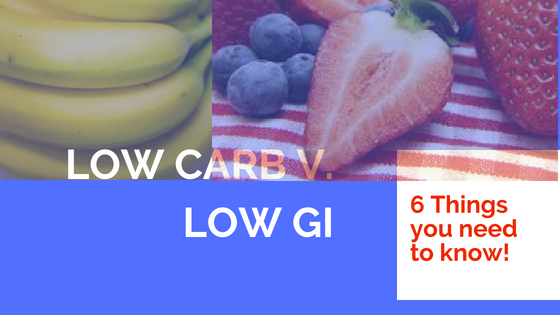I’ve always been baffled the difference between low GI and low carb. I wrongly assumed that they were one-in-the-same thing and that low GI foods must also be low in carbs (carbohydrates). Well, I was wrong!
Vanessa Furlong from the GI Foundation is a guru of all things GI and she lifts the lid on this mystery to help me clarify the confusion. Check out this interview for more info!
Q. What is the difference between low GI and low carb?
A. Low GI ‘diets’are more about the quality of the carbohydrate eaten, whereas low carb ‘diets’ are about the quantity of carbohydrates eaten.
The glycemic index (or GI) is a ranking of carbohydrates on a scale from 0 to 100, according to how much they raise blood sugar (glucose) levels after they’re eaten.
High GI foods are quickly digested, absorbed and metabolised and cause fluctuations in blood glucose levels.
Low GI foods (55 or less) are more slowly digested, absorbed and metabolised and cause a lower and slower rise in blood glucose and therefore usually, lower insulin levels too.
Low carb refers to the restriction of carbohydrates in the diet. There are three levels of low carbohydrate diets including very low, moderate and high carb. A very low carb diet has around ~50g or less of carbs per day and can lead to ketoacidosis.
Australian dietary guidelines recommend that for adults, carbohydrates should make up 45-65% of our total energy intake, or 230g-310g of carbs per day.
It’s important for anyone with t1d who is looking to start a low carb eating plan, to speak with their healthcare team.
Q. How is GI is calculated?
A. The GI values of foods have to be measured scientifically. The values can’t be guessed simply by looking at the ingredients or the nutrition panel on food packaging.
Foods with a high GI score contain carbohydrate which is rapidly digested by the body. This produces a large rapid rise and fall in blood glucose levels. In contrast, foods with a low GI score contain carbohydrate which is slowly digested; and this produces a gradual, lower rise in blood glucose levels.
Q. What are the general benefits of eating low GI foods?
A. Low GI foods are great for maintaining general health, but more importantly, it can reduce a person’s risk of developing type 2 diabetes and heart disease, and is also great for weight loss.
Q. What are the benefits of eating low GI foods for people with type 1 diabetes?
A. Low GI foods are great for anyone, but they are particularly beneficial for people with type 1 diabetes as they help to maintain stable blood glucose levels, require less insulin and therefore cause less fluctuations in blood glucose levels which helps reduce extreme highs and lows (hypos).
Q. What are your tips to help anyone with t1d avoid confusion?
A. Low GI doesn’t mean it will be low carb.
It’s always important to check the nutrition information on food packaging to make sure you are matching your insulin dose to carbs correctly.
Look out for the Low GI symbol on food packaging. If they feature the symbol, you can be sure they have been tested and certified to have a low GI (less than 55).

They also meet strict International Dietary Guideline standards for kilojoules, saturated fat and salt, making them among the healthiest choices!
Q. For those of us planning to hit the shops soon, can you list some low GI foods we can look out for?
A. We have created a handy shopping list guide, featuring a range of low GI foods from breads, to drinks, vegies, main meals, snacks and more!
For a more detailed list, including products and brands, check out our Swap It tool.
In case you missed it, read more about low-carb diets in my pervious post Navigating low-carb diets for people with type 1 diabetes .
About the GI Foundation: The Glycemic Index Foundation (GIF) is a not-for-profit health promotion charity supported by The University of Sydney and Diabetes NSW & ACT.
It aims to make Low GI healthy eating easy by providing the community with scientifically-backed information and tools to help improve their health. Check out the GI Foundation website for information, recipes, and a Swap It Tool to guide you to healthier Low GI options.




